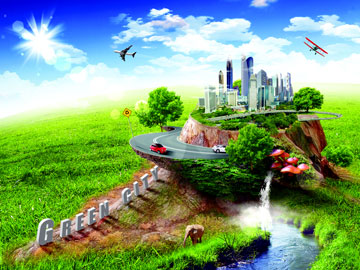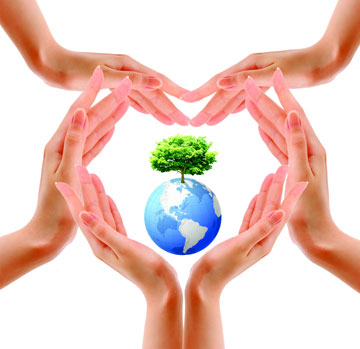MDG 7 - Seventh Millennium Development Goal
India’s Response to 'Ensure Environmental Sustainability'
India has made some progress towards the Seventh Millennium Development Goal (MDG) of ensuring environmental sustainability. Forest cover has increased to 21.02% and protected areas cover to about 4.83 % of the country’s total land area. Reducing the energy intensity of GDP growth through higher energy efficiency will be the key to achieving energy security.
The MDGs are eight international development goals that were established following the Millennium Summit of the United Nations in 2000, following the adoption of the United Nations Millennium Declaration. All 189 United Nations member states at the time (there are 193 currently) and at least 23 international organizations committed to help achieve the following Millennium Development Goals by 2015; that includes eradication of extreme poverty and hunger, achieve universal primary education, promote gender equality and empower women and reduce child mortality among others. MDG 7 being on 'Ensure Environmental Sustainability', gains importance in the context of sustainable environmental issues. It aims to integrate the Principles of Sustainable Development into Country Policies and Programmes and Reverse the loss of Environmental Resources.
 |
Additionally, there is increasing evidence of the ecological unsustainability of the current path of development, and of the growing chasm between rich and poor. Even the limited targets set under MDG7 on ensuring environmental sustainability have not been met; the interconnections between this and other goals continue to be weak or ignored. A fundamentally different framework of development, or well-being, is called for. If, as indicated by the outcome document of the United Nations Conference on Sustainable Development (Rio+20) of 2012,ecological sustainability has to be a major basis for such a framework, then a new set of global goals could include, among other things, equitable access to nature and natural resources to all peoples and communities, including the conservation and resilience of ecosystems, ecological cycles and functions, and biodiversity; access to adequate and safe food, water, energy, and settlements/habitat; access to conditions of good health, learning/education; and, in all these, meeting the special needs of women and children.
 |
Such a framework needs to be based on a set of universal principles, namely, respecting ecological integrity and limits, equity and justice, meaningful participation, responsibility, diversity, collective commons and solidarity, the rights of nature, resilience and adaptability, subsidiarity and ecoregionalism,and interconnectedness.
A set of principles can be feasible for the desired sustainability goals:
- The integrity of natural ecosystems, wildlife populations, and biodiversity must be safeguarded by reducing and eventually eliminating resource and biodiversity loss, and regenerating degraded ecosystems and populations.
- All people must have access to safe and adequate resources to fulfill basic needs, in ways that are ecologically sustainable and culturally appropriate.
- All families and communities must have access to dignified livelihoods that are ecologically sustainable and culturally appropriate.
- All production and consumption must be ecologically sustainable and socio-economically equitable, using a mix of incentives and disincentives.
- All infrastructure development must be ecologically sustainable and socio-economically equitable.
- All service and welfare sectors must integrate principles and practices of ecological sustainability.
- Macro frameworks of economy and polity must be geared to ecological sustainability, human security, and socio-economic equity.
Each of these goals contains specific targets and actions, and requires indicators to assess levels of success and failure.
Poverty, Development, Equity and Environment
 |
Sixty five years after gaining independence, it is clear that we are very far from achieving the basic objectives any society or civilization should aim for—security of food, shelter, water, health, and clothing, and fulfillment of human potential through educational, socio-cultural, and political opportunities. Depending on which measure one takes and whose estimates one believes, anything between a quarter and three-quarters of India’s population suffers from deprivations of one or the other kind. This includes economic poverty, malnutrition and under nutrition, lack of safe drinking water and sanitation, unemployment or underemployment, inadequate shelter, and other such situations that are violations of minimum standards of human rights and well-being. These are often so serious as to cause irreversible health damage, premature mortality and suicides. Many of these have roots in traditional socio-economic inequities and discrimination, which have been compounded, or added to, by the inequities and exploitation of modern times.
To this has been added the degradation of the natural environment on which we all depend for our lives, often to levels that are beyond recovery. Natural ecosystems are under stress and decline can be witnessed across most of the country with exceptions only in the case of some protected areas and community conserved areas; wild and agricultural biodiversity are under varying rates of erosion; well over half the available waterbodies are polluted beyond drinking, and often even beyond agricultural use; two thirds of the land is degraded to various levels of sub-optimal productivity; air pollution in several cities is amongst the world’s highest; ‘modern’ wastes, including electronic and chemical, are being produced at rates far exceeding our capacity to recycle or manage; and so on. A 2008 report suggests that India has the world’s third biggest ecological footprint, that its resource-use is already twice of its bio-capacity, and that this bio-capacity itself has declined by half in the last few decades (GFN and CII 2008). Economic globalization since 1991 has significantly worsened the negative trend by increasing rates of diversion of natural ecosystems for ‘developmental’ purposes, and rates of resource exploitation for domestic use and exports (Shrivastava and Kothari 2012). Climate change impacts are being felt in terms of erratic weather and coastal erosion, and the country has little in the way of climate preparedness, especially for the poor who will be worst affected (Bidwai 2011; Thakkar 2009). Projections based on the historic trend of materials and energy use in India also point to serious levels of domestic and global impact on the environment if India continues on its current development trajectory modeled on industrialized countries (Singh et al 2012).
While discussions on the aspects above have been extensive, the interconnections between continued or new deprivations, including poverty, environmental degradation, and inequities on the social, economic, and political fronts have not been brought out in such a detailed manner. Or, conversely, neither have the positive interactions amongst poverty eradication, environmental sustainability, and empowerment. Thus, planning and programmes of the government, and usually those even of civil society, focus on one or the other element of the picture, in the process ignoring or even negatively impacting other elements. For instance, several poverty eradication or food security programmes are ecologically damaging (for example, chemical-intensive agriculture); conversely, several environmental protection programmes exacerbate poverty or create new forms of deprivation (examples being exclusionary protected areas for wildlife that forcibly displace resident communities, or watershed programmes that stop pastoralists’ access without providing alternatives).
Policy Frameworks
Several policy pronouncements of the Government of India, such as the National Environment Policy 2006 or the Approach Papers of various Five Year Plans, have promised the integration of development and environment. These policy frameworks, as also the implementation of the MDGs, could have been opportunities for a holistic pathway towards sustainable, equitable well-being for all of India’s people.
There is, however, little evidence that these policy pronouncements have been followed up with actual action to achieve such holistic well-being. Contrarily, in fact, the country has headed towards greater unsustainability and inequity. An integrated approach to human well-being that enhances the economic, social, and political opportunities for those traditionally or currently deprived, curbs the obscene levels of wealth and consumption of the super-rich, conserves nature and sustains the ecological basis and resilience so crucial for our existence, is not evident in the priorities of the government.
This is not to belittle a number of positive initiatives by the state relating to poverty, environment, employment, and empowerment. Nor is it to hide the exciting and innovative work done on these fronts by many communities, civil society organizations, institutions and private sector agencies. All of these are indeed elements of a more sustainable and equitable future. However, at present these are submerged and overwhelmed by the sheer bulldozer effect of current macroeconomic policies and political governance structures that are taking India further down the path of unsustainability, deprivation, and inequity. A number of course corrections, including better implementation of progressive policies and programmes that already exist, reforms in other existing policies and programmes to make them more progressive, and fundamental changes in pathways of development and governance are necessary if holistic human well-being is to be achieved. This must also avoid the pitfalls of myopic or false solutions such as carbon markets, geo-engineering, and supposedly renewable sources like nuclear power and large hydropower. The post-2015 framework for ‘sustainable development’5 provides an opportunity to head in this direction.
India's record on MDG7
Implementation of globally specified targets and indicators India’s latest report on MDG implementation (GOI 2011) contains a section on MDG7. On a number of indicators, such as forest cover, consumption of ozone-depleting substances, access to safe drinking water and sanitation facilities, some to substantial progress is reported; on others like CO2 emissions, and growth of slums, the story is not positive.
India’s Achievement of MDG7 (as officially reported)
Target 7A (Integrate principles of sustainable development into country policies and programmes, and reverse the loss of environmental resources):
- Forest cover has increased by 3 million hectares (m.ha.) in the last decade; between 2005 and 2007, it has increased by 72,800 hectares; the Green India Mission aims to increase forest and tree cover in 5 m.ha., and improve forest quality in another 5 m.ha.
- Protected areas cover 4.90 per cent of the country’s land area, having increased by about 70,000 hectares from 1999 to 2011.
- Energy intensity (energy used per unit of GDP) has remained more or less at the 1970–71 levels, having increased significantly in the 1970s and 1980s but declined again in the last two decades.
- CO2 emissions have ‘experienced dramatic growth’, with India becoming the world’s third largest CO2 emitting country; coal burning is the single biggest contributor.
- Consumption of ozone-depleting substances per capita is still very low;6 CFC consumption has sharply declined. Target 7B (Reduce biodiversity loss, achieving, by 2010, a significant reduction in the rate of loss)
- (missing from the report, presumably integrated into the above) Target 7C (Halve by 2015, proportion of people without sustainable access to safe drinking water and basic sanitation):
- Proportion of households without access to safe drinking water has reduced significantly from about 34 % in 1990 to about 9 per cent in 2008–09, and India is on its way to 100 per cent coverage for safe drinking water by 2015 (surpassing the MDG targets).
- Proportion of households without sanitation facilities has reduced from about 76 per cent in 1990 to about 50 % in 2008–09 (at which rate, 43 per cent will remain without such facilities, missing the MDG target by about 5 % points).
- Target 7D (By 2020, a significant improvement in the lives of at least 100 million slum dwellers):
- Slum population increased from 46.26 million in 1991 to 61.82 million in 2001; while the number of slums declined about 13 per cent from 1993 to 2008–09, the latest estimate of slum population is not available.
- Marginal improvement is reported in facilities to slumdwellers, between 2002 and 2008–09.
Source: GOI 2011
A number of actions taken by the government have indeed helped in safeguarding the country’s environment to some extent. For instance, the network of protected areas is likely to have staved off some key threats to wildlife and natural ecosystems in 4–5 per cent of India’s territory. Legal and programmatic measures related to many other ecosystems and wildlife species, including those listed in the above report, have also contributed to biodiversity conservation. Similarly, the legal requirement of development projects having to obtain ‘environmental clearance’ and ‘forest clearance’ has brought in some focus on environmental impacts. A number of innovative water harvesting and distribution projects have helped reduce the number of people without access to safe and adequate water.
 |
However, beyond the specific indicators reported by India, there is a more serious issue. There is no indication of a comprehensive or systematic integration of the principles of sustainable development into India’s policies and programmes. Nor is there evidence that the rate of biodiversity loss has been reduced, or that ecosystem resilience has increased. There are a number of flaws and weaknesses related to how these targets are being addressed (Kohli and Menon 2005, Kohli et al 2009, Kothari 2011 & 2012, Saldanha et al 2007):
- Measures like EIA/environmental and forest clearance have remained piecemeal (for example, missing out on sectors like tourism), badly implemented, and so filled with holes that it has been easy for the most destructive projects to slip through.
- There are no procedures for assessing the cumulative impacts of related projects (like a series of hydro projects on a single river), nor for assessing the impacts of sectors (such as the mining or power sector as a whole), nor are there any procedures for social impact assessment (which is related to environmental impacts).
- During the process of putting together Five Year Plans, annual budgets, and macroeconomic measures that drive the country’s development process, there is absolutely no assessment of their environmental impacts. Nor does sustainability get built into the design of macroeconomic policies (such as taxing speculative finance that has a bearing on the environment, or heavily taxing mining activities); environment is mostly an afterthought or an aside.
- Despite repeated talk and recommendations at many policy forums, natural resource limits as a constraint or framework within which economic planning should take place (including even through the limited approaches of natural resource accounting or budgeting) have never been employed.7
- The annual Economic Survey of the Government of India deals with environment in a handful of pages as a separate section, with little or no interconnections drawn with the economic sectors that form the bulk of the report; the Surveys of 2012 and 2013 have an additional chapter on ‘Sustainable Development and Climate Change’, but linkages with other chapters remain weak or absent.
- There is no national land–water use plan, which could specify priorities on how various kinds of lands and regions are to be used in a way that would ensure ecological (and related livelihood) security. As a result of this, even the most fragile and ecologically crucial areas are subject to damaging activities— land use changes such as from agriculture to industry are undertaken with little heed for their consequences, often at the behest of those interested in ‘real estate’ values rather than production of goods, and water sources crucial for drinking and agriculture are diverted to industries.
- There is no set of indicators on sustainability in use by the Planning Commission or any other government body at the center or in the states. There is some reporting on sustainability by corporations and organizations, following up on the National Voluntary Guidelines on Social, Economic, and Environmental Responsibilities of Business by the Ministry of Corporate Affairs and using frameworks such as that of the Global Reporting Initiative,8 but this is still very preliminary and piecemeal, and in any case not mandatory.
- Forest lands are being diverted for industrial, developmental and other projects at an increasing rate in the last couple of decades. The same is possibly true of coastal areas, though figures are not readily available as in the case of forests. Fisheries exploitation has reached proportions already resulting in decline in fish stocks in parts of the Indian Ocean which are near the shore. Productive agricultural lands are being diverted to SEZs, industry, and other such uses, or from food crops to non-food cash crops. In all these cases there are no comprehensive measures to ensure that sustainability is achieved. Even legislations such as the Forest Conservation Act or the Coastal Zone Regulation notification under the Environment Protection Act are observed more in the breach.
As mentioned earlier, available reports suggest that India’s current pathways of development are unsustainable. It does not appear that the MDGs have made much of a dent in this situation, or that India’s planning processes have changed significantly enough to address this issue.
Gaps in globally specified indicators
The indicators specified at a global level are clearly not the only ones that could or should be included within the overall goal of environmental sustainability. Each country is free to go beyond these to add other priority actions and related indicators. Judging by the country report, there is no evidence that India has done this—at least not explicitly in connection with the MDGs. A number of environmental aspects are missing from the indicators reported: levels of air, water, soil and noise pollution, status of natural ecosystems other than forests, number of threatened species, levels of toxic chemicals in food and water, trends in recycling, sustainability of production and consumption patterns, and many more.
Goals and targets
A mix of goals and targets mentioned further are a mix of those that entail a basic systemic change (‘revolution’) and those that are expanding or using spaces within the existing system (‘reforms’). Hopefully, there are no contradictions between the two, with the reforms being seen as transitional towards the revolution. These are aspects that need to be dealt with in further iterations and elaboration of this approach.
A conscious and concerted focus is needed on reducing the enormous ecological footprints of big cities, sustained through the parasitism of urban areas on rural ones, and the denial of opportunities for the latter to evolve vibrant economies and socio-cultural processes. Those areas in transition from villages to small towns and small towns into cities can build in principles and strategies of sustainability at an early stage.
Goal 1: The integrity of natural ecosystems, wildlife populations, and biodiversity, must be safeguarded by reducing and eventually eliminating resource and biodiversity loss, and regenerating degraded ecosystems and populations.
Goal 2: All people must have access to safe and adequate resources to fulfill basic needs, in ways that are ecologically sustainable and culturally appropriate.
Goal 3: All families and communities must have access to dignified livelihoods that are ecologically sustainable and culturally appropriate.
Goal 4: All production and consumption must be ecologically sustainable and socio-economically equitable, using a mix of incentives and disincentives.
Goal 5: All infrastructure development must be ecologically sustainable and socio-economically equitable.
Goal 6: All service and welfare sectors must integrate principles and practices of ecological sustainability.
Goal 7: Macro frameworks of economy and polity must be geared to ecological sustainability, human security, and socio-economic equity.
Challenges and next steps
Moving towards a comprehensive framework of sustainability, along with human security and equity, is obviously easier said than done. A number of serious obstacles and challenges will need to be overcome, which include:
Knowledge, capacity and expertise gaps: Despite the enormous strides in science, our understanding of the ecological dynamics of our world is still limited. The chasm between modern and traditional knowledge has meant that the insights and information of the latter are not available to today’s decision-makers, and the capacity to deal with the huge ecological problems we have created is limited.
Political apathy and hostility: There is an inherent resistance to major change in centralized political systems, and often those in power are either themselves profiting from the current economic system, or heavily influenced by others profiting from it.
Corporate power: The enormous profits that corporations make from the currently unsustainable economic system, coupled with their hold on most nation-states and their lack of accountability to the public, are a major source of resistance to change. People’s movements and responsive governments have to move to reduce the clout of corporations, facilitate alternative, people-based production, business, trade and exchange, and regulate/incentivize corporations towards practices of sustainability.
Military interests: The military is a powerful influence in most countries, is not known to be particularly interested in or sympathetic towards issues of ecological sustainability, and indeed has a strong vested interest in continuing the status quo. It is important for ecological and justice–equity movements to have a strong peace and demilitarization angle, along with ongoing dialogue on how ecological and socio-economic security are much better ways to secure populations than the military.
Public apathy and attitudes: Decades of the current system have created a sense of apathy or helplessness, or worse, have co-opted the public into believing that salvation lies in unending consumption. Even the oppressed dream the same dreams as their oppressors. Much sensitization work is needed by civil society and governments to create mass public awareness of the abyss we are falling into, and of the need to explore different pathways towards genuine human well-being.
To move towards a post-2015 framework that integrates ecological sustainability, human security and equity, few important steps have to be considered:
- Assessment of various visions and frameworks being proposed globally or in individual countries, from which India could learn, adopt, and evolve its own framework as suitable for its ecological, cultural, economic and political context.
- Consolidation of information already available on trends in sustainability and unsustainability (such as those on use of agricultural chemicals, or air pollutants, in Roy and Chatterjee 2009; on forest cover,carbon emissions, drinking water and sanitation in GOI 2011; on energy intensity of industries in Rao et al 2009, and so on).
- Initiation of public discussions and consultations involving all sections, particularly local communities, in rural and urban areas to expand the understanding of the fundamental problems with the current system, as also to generate inputs to the post-2015 framework at both national and global levels.
- Review of current macroeconomic and political governance structures, assessment of current levels of ecological unsustainability, and related human insecurity and inequity, using tools such as those listed above, and delineation of specific macroeconomic and governance changes needed to move towards a framework of sustainability.
- Discussion on new framework at political levels, including in relevant parliamentary standing committees, towards a political commitment in the National Development Council to conceptualize the 13th Five Year Plan within this framework.
It is very unlikely that the Indian government will on its own move towards a radically different framework than the one currently in operation. There is a crucial role for people’s movements, civil society organizations, academic think-tanks, and progressive political leaders to push it in this direction.
 |
Moreover, it should be obvious that India cannot forge such paths alone, not least because of the incredibly complex ways in which it is already intertwined with other nations and with the earth as a whole. It will need to do so in partnership with other countries, and within the context of evolving global frameworks. Still, it cannot simply be a recipient of these frameworks. It must be one of the champions of new global processes towards sustainability and equity, pushing especially the vision of earth, and within that, humanity, as one, even while respecting the diversity of peoples and communities within this whole. So even as the above exercise is carried out for domestic purposes, at the international level India and its communities must also advocate a central focus on sustainability, along with human security and equity for the global post-2015 framework. Given that ecological collapse and global inequities will most seriously impact people in countries like India, such advocacy is not only to show its responsibility towards the earth, and indeed all humanity, but also to safeguard the interests of the peoples and nature it harbors.
References:
- http://www.oxfamindia.org/sites/default/files/Working%20paper%2016_0.pdf
- http://mospi.nic.in/mospi_new/upload/MDG_pamphlet29oct2013.pdf
- http://www.in.undp.org/content/india/en/home/mdgoverview/overview/mdg7/